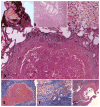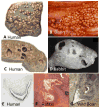Pathology of post primary tuberculosis of the lung: an illustrated critical review
- PMID: 21733755
- PMCID: PMC3215852
- DOI: 10.1016/j.tube.2011.03.007
Pathology of post primary tuberculosis of the lung: an illustrated critical review
Abstract
Post primary tuberculosis occurs in immunocompetent adults, is restricted to the lungs and accounts for 80% of all clinical cases and nearly 100% of transmission of infection. The supply of human tissues with post primary tuberculosis plummeted with the introduction of antibiotics decades before the flowering of research using molecular methods in animal models. Unfortunately, the paucity of human tissues prevented validation of the models. As a result, it is a paradigm of contemporary research that caseating granulomas are the characteristic lesion of all tuberculosis and that cavities form when they erode into bronchi. This differs from descriptions of the preantibiotic era when many investigators had access to thousands of cases. They reported that post primary tuberculosis begins as an exudative reaction: a tuberculous lipid pneumonia of foamy alveolar macrophages that undergoes caseation necrosis and fragmentation to produce cavities. Granulomas in post primary disease arise only in response to old caseous pneumonia and produce fibrosis, not cavities. We confirmed and extended these observations with study of 104 cases of untreated tuberculosis. In addition, studies of the lungs of infants and immunosuppressed adults revealed a second type of tuberculous pneumonia that seldom produces cavities. Since the concept that cavities arise from caseating granulomas was supported by studies of animals infected with Mycobacterium bovis, we investigated its pathology. We found that M. bovis does not produce post primary tuberculosis in any species. It only produces an aggressive primary tuberculosis that can develop small cavities by erosion of caseating granulomas. Consequently, a key unresolved question in the pathogenesis of tuberculosis is identification of the mechanisms by which Mycobacterium tuberculosis establish a localized safe haven in alveolar macrophages in an otherwise solidly immune host where it can develop conditions for formation of cavities and transmission to new hosts.
Copyright © 2011 Elsevier Ltd. All rights reserved.
Conflict of interest statement
Figures









References
-
- Dubos R, Dubos G. Tuberculosis, Man, and Society. Brunswick, NJ: Rutgers Univesity Press; 1987. The White Plague.
-
- Garay S. Pulmonary Tuberculosis. In: Garay WRS, editor. Tuberculosis. Chapter 32. Boston: Little Brown & Co; 1996. pp. 373–412.
-
- Leong FJ, Dartois V, Dick T. A Color Atlas of Comparative Pathology of Pulmonary Tuberculosis. New York: CRC Press; 2011.
-
- McGrath JW. Social networks of disease spread in the lower Illinois valley: a simulation approach. Am J Phys Anthropol. 1988;77:483–96. - PubMed
-
- Donald PR, Marais BJ, Barry CE., 3rd Age and the epidemiology and pathogenesis of tuberculosis. Lancet. 2010;375:1852–4. - PubMed
Publication types
MeSH terms
Substances
Grants and funding
LinkOut - more resources
Full Text Sources
Medical
Research Materials

